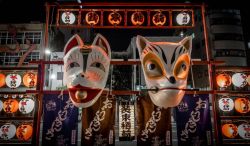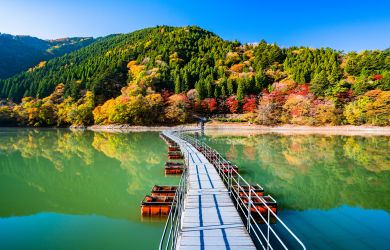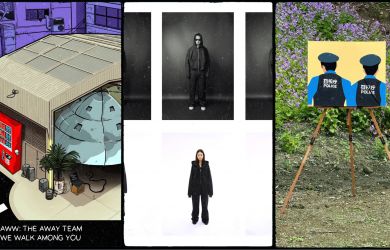
May 19, 2010
High Art
Since its opening five years ago, a reclusive sect's stunning museum has attracted wide international acclaim. Tama Miyake travels to the mountaintop.
By Metropolis
Originally published on metropolis.co.jp on May 2010

Photos Courtesy of Miho Museum
Standing on French limestone the color of ocean sand, we watched as snowflakes drifted from low clouds, the wind picking them up and tossing them into the crystal-clear glass that stood between us and a vista of tree-lined mountains. After more than four hours by taxi, shinkansen, subway and bus through Nagoya and Kyoto, over muddy rivers and past seaside villages, through valleys and bamboo groves, we had finally arrived at our final destination: an I.M. Pei-designed Shangri-la.

Miho Museum peeks over the horizon of a vast nature preserve in Shigaraki, Shiga Prefecture, an hour’s drive from the famous temples of Kyoto. Alone among the cherry trees and howling winds, this five-year-old art museum founded by the Shinji Shumeikai, a religious sect known in English as the Shumei Family, is little known throughout Japan. But thanks to its dramatic design by Pei, the renowned architect who also designed Phase I and II of the Grand Louvre in Paris, the “Museum on the Mountain” is widely celebrated throughout Western design circles.
Had we arrived two days earlier, we would have been rubbing shoulders with American domestic icon Martha Stewart and Hiroko Koyama, daughter of the sect’s founder and its current president. Stewart, who has visited the museum several times since its opening in November 1997, even made the trip here when she was grounded in Japan during the aftermath of September 11. Fashion designer Giorgio Armani and style arbiter Elsa Klench are only a few of the others who have traveled to this unique mountaintop.

Great heights
The bus that took us from Ishiyama Station to Miho Museum snaked along a rocky riverbed, climbing from the Lake Biwa valley into the Shigaraki Mountains. The winding journey took us past barren fields still emerging from the winter freeze, men sweeping streets outside low wooden houses, tennis players practicing on courts wrapped in green mesh, and uniformed construction workers blasting their way into a hillside. Eventually leaving the convenience stores and pachinko parlors behind us, we emerged from a tunnel into a small farming community and took our first breath of cold mountain air fresh with pine.
The bus, which shuddered every time we stopped, struggled still higher to manicured entrance of the museum grounds. The final stage of our journey involved a slow drive in a golf cart through a high, curved tunnel and over a cantilevered bridge across a deep ravine.

The museum’s secluded location and elaborate approach reflect Pei’s inspiration for its design, the Chinese poem “Peach Blossom Spring” by Tao Yuan Ming. The poem tells the story of Wu-ling, a fisherman who happened upon a peach orchard in full bloom. Intrigued, he rowed his boat to the end of the grove and found a small cave emitting a bright light. Wu-ling entered the cave and followed a narrow road until a splendid village surrounded by lush fields and forests suddenly came into view. Pei, who likens the mountains and mist of Shigaraki to the countryside in his native China, said on his first visit to the site, “This is Shangri-la.” s
After climbing wide granite stairs, designed to evoke the entrance to a Japanese temple, we entered the front door and were immediately drawn to the framed view of vast green peaks cloaked in mist. To our left, we could see the Mt Fuji-esque roof of Meishusama Hall, the Shinji Shumeikai’s 50-meter-high mountaintop sanctuary designed by Minoru Yamasaki, architect of New York’s World Trade Center towers, and the 60-meter-high Bell Tower designed by Pei in 1990.

The spiritual and slightly mysterious aura seemed to close in further as we watched the brief snow shower pass over the mountains, fueled by the fierce winds that howled outside the windows.
Art for art’s sake
Despite attracting more than 100,000 visitors each year from as far afield as Belgium and Germany, the secretive nature of the museum’s founders has kept most Japanese from making the pilgrimage to Miho. But rather than a religious experience, our trip was a lesson in hospitality and appreciation for art and nature.

But maybe that was exactly the point, considering the Shinji Shumeikai’s entire philosophy is centered on enhancing the quality of life through jyorei (purification of the spirit) and appreciating beauty in all its forms. Our baptism began at the heart of the Shumei Family collection: the Japanese tea ceremony objects.
The centerpiece of the collection, the Yohen Tenmoku Tea Bowl, is one of only four of its kind existing in the world. Dating back to 12th-13th century in China, this delicate black bowl with iridescent spots was displayed in a simple glass case among ancient Buddhist artifacts and scrolls dating back to the 8th century.

Moving between the darkened underground galleries and sun-bathed halls, we explored the arts of Egypt, China, ancient Greece, and even Afghanistan. At the entrance to the Egypt gallery, we were greeted by a life-size granite statue of Queen Arsinoe II, wife of Ptolemy II (270-246 BC). A massive Buddha, standing more than 8ft tall, seemed to reign over the South Asia gallery, his serene face and bare feet exuding a meditative serenity.
If the intent of this reclusive museum was to inject some calm and beauty into our workaday lives, the Shinji Shumeikai had succeeded. But the stark contrast between this no-cost-spared mountaintop retreat and the working-class valley below left us wondering if this wasn’t some kind of mirage. After all, Shangri-la doesn’t really exist.
Or does it?
Getting there
Miho Museum is only accessible by car or bus. The drive from Kyoto takes about one hour. The bus from Ishiyama Station, 15min from Kyoto Station via JR, takes 50 minutes and costs ¥800.
Where to stay
There are two ryokan in Shigaraki, the closest town and a 20-minute drive from the museum. Ogawa-tei (0748-82-0008) offers lodging, a kaiseki dinner and Japanese breakfast for ¥11,000-14,000 per person. Shira-okaya (0748-82-0875) offers similar packages for ¥11,000-15,000 per person.
Information
The museum is open Mar 15-Jun 9, Jul 20-Aug 18, and Sep 1-Dec 15. Admission is ¥1,000 for adults, ¥800 for students, and ¥300 for children under 16. Audio tours are available in English and Japanese. Call 0748-82-3411 or see www.miho.or.jp for further information.
[geo_mashup_map]





